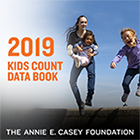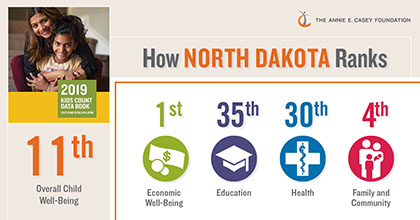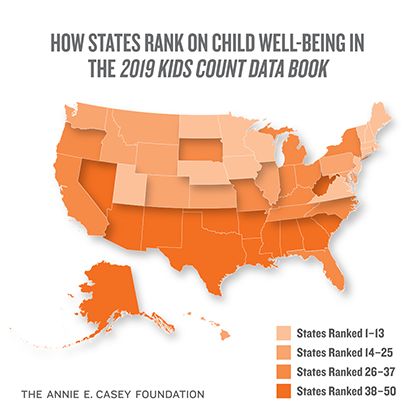Ask A Researcher
July 2019
The 30th edition of the Annie E. Casey Foundation’s KIDS COUNT® Data Book finds that 175,772 children will shape the future of a more diverse North Dakota.

Karen Olson is the program director for North Dakota KIDS COUNT, a program sponsored by the Annie E. Casey Foundation and housed in the Center for Social Research at North Dakota State University. KIDS COUNT recently released the 2019 KIDS COUNT® Data Book, an annual assessment of children’s well-being in the United States. In this article, Karen offers some insight into the 2019 Data Book, and how North Dakota ranks in regards to the well-being of children and youth.
The 30th edition of the Annie E. Casey Foundation’s KIDS COUNT® Data Book was released on Monday, June 17th, 2019. The annual KIDS COUNT Data Book uses 16 indicators to rank each state across four domains —economic well-being, family and community, education, and health — that represent what children need most to thrive.
The report begins by exploring how America’s child population — and the American childhood experience — has changed since the publication of the first Data Book in 1990. In 1990, North Dakota was home to 170,920 children. Due largely to out-migration, this number steadily decreased to a low of 143,000 by 2008. And then things changed. One of the results of energy development activity which drew a lot of people to the state for work – people in their prime child bearing years – was an increase in total births beginning around 2002. This led to an increase in the total number of children ages 0 to 17 beginning around 2008. So, from 2008 to 2017, the child population grew an average of 2 percent annually reaching around 176,000 children in 2017 – a level we haven’t seen since 1990.
A growing child population is good for North Dakota if we invest in them now, educate them and enable them to contribute to our economy, and become a strong, well educated workforce that will support another growing population, our aging baby boomers. The oldest baby boomers (the large population cohort born from 1946 to 1964) are now 73 years old and the youngest are 55 years. So, in another 10 years, nearly all baby boomers will be of retirement age.
The more immediate implications of a growing child population are significant in terms of school enrollments and child care supply and demand. It is important to note that North Dakota has one of the largest percentages of working parents in the nation. Thus, reliable and affordable child care can help provide parents with greater opportunity to be productive at work and in school. In addition, high-quality child care nurtures, stimulates, and supports children as they build the confidence and critical capacities they need to thrive in school and life.
As North Dakota’s child population grows, it is also becoming more diverse. Combined, American Indian, African American, Asian, and Hispanic/Latino children comprised 9 percent of all North Dakota children in 1990. By 2017, the number of non-white and Hispanic children more than doubled to 21 percent. While children of different races and ethnicities often show large variation in well-being including health, school performance, and access to family and community resources, they saw gains during the reporting period in our state. Therefore, our public policies need to identify, acknowledge, and strengthen promising efforts – efforts that have reduced the teen birth rate, reduced poverty, increased access to health insurance, and improved graduation rates for our minority children and youth.
The 2019 KIDS COUNT Data Book continues with a state-to-state comparison of overall child well-being. Overall, North Dakota ranks 11th in the nation for child well-being. Although North Dakota ranks well in economic and family and community indicators, several challenges exist with respect to education and health that could limit the ability of children to reach their full potential. In addition, it is important to note that statewide figures and overall averages can mask what is happening at a local level and among certain populations. For example, while we have the second lowest child poverty rate among states, there are nearly 20,000 children in North Dakota living in families struggling every day – families that do not earn enough money to put food on the table, pay for health care, transportation, rent or mortgage payments, utilities, child care, and clothing. Another 30,000 children live in families that perhaps don’t fit the poverty definition, but are earning just enough to cover day to day expenses and likely have no savings for emergencies.
In addition, in the 2019 Data Book, North Dakota ranks:
- First in economic well-being.North Dakota continues to lead the nation in the economic well-being of children. Among states, North Dakota has the lowest percentage of children in families with a high housing cost burden (18 percent); the lowest percentage of teens not attending school and not working (4 percent); the second-lowest child poverty rate (11 percent); and the sixth-lowest percentage of children without secure parental employment (22 percent).
- Fourth in the family and community domain.When compared with other states, children in North Dakota fare well in terms of family and community indicators. Five percent of North Dakota children live in families where the head of household lacks a high school diploma and 27 percent of children live in a single-parent family. The national averages are 13 percent and 34 percent, respectively. Since 2010, North Dakota saw faster rates of decline in the teen birth rate and in the percentage of children living in high-poverty neighborhoods than at the national level.
- 35th in education.Despite a minor improvement in the on-time high school graduation rate from 2016 to 2017, two-thirds of fourth-graders are not proficient in reading, 60 percent of eighth-graders are not proficient in math and 69 percent of North Dakota three- and four-year-olds are not enrolled in prekindergarten programs.
- 30th in health. From 2010 to 2017, the child and teen death rate decreased from 34 per 100,000 to 30 per 100,000 in North Dakota and there was no change in the percentage of babies born with a low birth weight. However, the uninsured rate for children in North Dakota has risen to 8 percent since 2010 and remains nearly twice the national average. About 4 percent of teens reported abusing alcohol or drugs in the past year, both in the state and at the national level.

Trends are shaped by many forces, but these data provide us an opportunity to better understand the challenges facing children and families in our state and to strategically invest in their futures.
The Data Book calls on elected officials and representatives to:
- Expand the programs that make and keep kids healthy. Nearly half of uninsured children in North Dakota live in low-income families — with incomes below 200 percent of the federal poverty level — making them potentially eligible for coverage through Medicaid and Healthy Steps (i.e., Children’s Health Insurance Program or CHIP).
- Provide the tools proven to help families lift themselves up economically. Federal and state earned income tax credits (EITC) and child tax credit programs mean working parents can devote more resources to meeting their children’s needs.
- Embrace strengths and what is working for all children. Every child has incredible individual potential, and communities thrive when all kids thrive. Our public policies must acknowledge and strengthen promising efforts – and at the same time address ethnic and racial inequities.
- Count all kids. Ensure the 2020 census counts all children, including those under 5 years old and from hard-to-count areas. In North Dakota, approximately 4,000 young children live in these hard-to-count areas. When children aren’t counted, state and local infrastructures face losing millions of federal dollars for supports. Census-derived data are used to distribute more than $1.45 billion a year to North Dakota, including $331 million directly to children for programs covering health (Medicaid, Healthy Steps), education (Title I, Head Start, Special Education), food security (SNAP, School Lunch, and WIC), foster care, and child care.
All of the nearly 176,000 children in our increasingly diverse state have the potential for brighter futures, and we have the data, knowledge, and evidence for what it takes to make that vision a reality in North Dakota.
For a new, interactive approach to viewing the Data Book, be sure to take a look at this year’s “Data Book Interactive” which allows users to compare a state’s performance regionally and nationally. Also new this year are two short videos that shed light on how the child population has changed since 1990 and how states compare in areas of child well-being. These quick, two-minute videos end with a simple message worth repeating – that all kids have incredible potential and deserve an opportunity to thrive!

